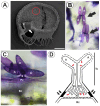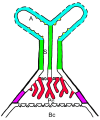Cell Wall Microdomains Analysis in the Quadrifids of Utricularia dichotoma
- PMID: 39859547
- PMCID: PMC11766393
- DOI: 10.3390/ijms26020832
Cell Wall Microdomains Analysis in the Quadrifids of Utricularia dichotoma
Abstract
Carnivorous plants have fascinated botanists and ecologists with their various unusual adaptations in organ structure, physiology, and complex interactions with other organisms since the time of Charles Darwin. Species of the genus Utricularia (bladderworts, family Lentibulariaceae) are carnivorous plants that prey mainly on invertebrates using traps (bladders) of leaf origin. In the traps, there are glandular trichomes called quadrifids, which produce digestive enzymes and absorb the products of prey digestion. These quadrifids are unique due to their highly complex glandular cell structure; hence, they are an excellent model for studying the cell wall and its specialization. The main aim of the study was to investigate the presence and distribution of homogalacturonans (HGs) and hemicelluloses in the cell walls of trichome cells and especially in cell wall ingrowths in the quadrifid cells. The following antibodies were used against the wall components: anti-HGs (homogalacturonans) -JIM5 (low methylesterified HGs), JIM7 (highly esterified HGs), LM19 (low methylesterified HGs), CCRC-M38 (a fully de-esterified HG), LM5 (galactan); anti-hemicelluloses-LM25 (galactoxyloglucan; XXLLG, XXLG, XXXG modules of xyloglucans), LM15 (xyloglucan), CCRC-M138 (xylan), LM11 (heteroxylan); and anti-mannans: LM20 (heteromannan) and LM22 (heteromannan). The localization of the examined compounds was determined using immunohistochemistry techniques and immunogold labeling. In quadrifid cells, we found differences in the presence of the epitope detected by the LM5 antibody in the cell walls. In addition, cell wall ingrowths represented distinct microdomains of the cell wall in terms of the occurrence of wall components (they were methylesterified and demethylesterified homogalacturonan-poor). Hemicelluloses (galactoxyloglucan and xyloglucan) and arabinogalactans co-occur in cell wall ingrowths. Also, a part of the cell wall of the pedestal cell, which forms a Casparian strip, represented a distinct microdomain. We did not detect epitopes recognized by LM11, LM20 and LM22 antibodies. Our research shows that several cell wall microdomains occur in the cell walls of quadrifid cells. They differ depending on the presence and distribution of low methylesterified HGs, highly esterified HGs, fully de-esterified HGs, galactan (the epitope detected by the LM5 antibody), xyloglucan, galactoxyloglucan, and xylan (the epitope detected by the CCRC-M138 antibody).
Keywords: Lentibulariaceae; cell wall; cell wall microdomains; digestive trichomes; glands; hemicelluloses; pectic homogalacturonan; scanning transmission electron microscopy; transfer cells; xylan; xyloglucan.
Conflict of interest statement
The authors declare no conflicts of interest.
Figures











Similar articles
-
Homogalacturonans and Hemicelluloses in the External Glands of Utricularia dichotoma Traps.Int J Mol Sci. 2024 Dec 6;25(23):13124. doi: 10.3390/ijms252313124. Int J Mol Sci. 2024. PMID: 39684835 Free PMC article.
-
Do Arabinogalactan Proteins Occur in the Transfer Cells of Utricularia dichotoma?Int J Mol Sci. 2024 Jun 16;25(12):6623. doi: 10.3390/ijms25126623. Int J Mol Sci. 2024. PMID: 38928328 Free PMC article.
-
Immunocytochemical Analysis of the Wall Ingrowths in the Digestive Gland Transfer Cells in Aldrovanda vesiculosa L. (Droseraceae).Cells. 2022 Jul 16;11(14):2218. doi: 10.3390/cells11142218. Cells. 2022. PMID: 35883661 Free PMC article.
-
Probing homogalacturonan in situ: A comprehensive review of available molecular recognition tools.Int J Biol Macromol. 2025 Jun;311(Pt 4):143752. doi: 10.1016/j.ijbiomac.2025.143752. Epub 2025 Apr 30. Int J Biol Macromol. 2025. PMID: 40316075 Review.
-
Primary cell wall metabolism: tracking the careers of wall polymers in living plant cells.New Phytol. 2004 Mar;161(3):641-675. doi: 10.1111/j.1469-8137.2004.00980.x. Epub 2004 Jan 16. New Phytol. 2004. PMID: 33873719 Review.
References
-
- Juniper B.E., Robbins R.J., Joel D.M. The Carnivorous Plants. Academic Press; London, UK: 1989.
-
- Ellison A.M., Adamec L. Carnivorous Plants: Physiology, Ecology, and Evolution. Oxford University Press; Oxford, UK: 2018. 510p
-
- Darwin C. Insectivorous Plants. 1st ed. John Murray; London, UK: 1875.
-
- Lloyd F.E. The range of structural and functional variety in the traps of Utricularia and Polypompholyx. Flora. 1932;126:303–328. doi: 10.1016/S0367-1615(17)31166-7. - DOI
MeSH terms
Substances
Grants and funding
LinkOut - more resources
Full Text Sources

